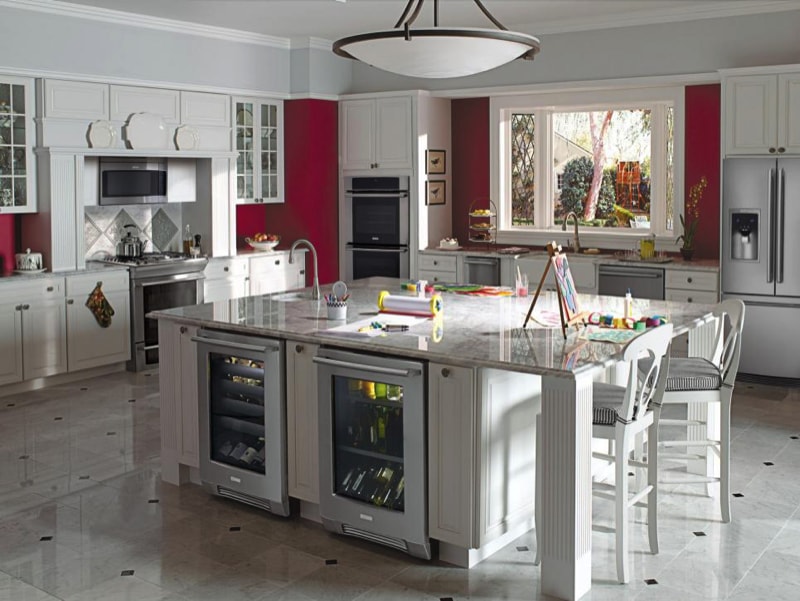 Image via Electrolux.com
Image via Electrolux.com
Page Topics
Choosing The Best Home Kitchen Appliances For Your Needs
The process of renovating a kitchen or building one from new involves a number of important decision making steps.
Then when you try and factor in purchasing new home kitchen appliances like refrigerators, ovens, dishwashers, sink waste disposals, and the like, it can seem overwhelming. However, despair not.
We have some important points to consider or take into account in the checklist below that should hopefully make the task easier for you.
You may recall from our earlier section on “Understanding Kitchen Costs“, that we indicated that a typical allowance for spending on Appliances and Ventilation should come in at around 14%.
So if you had an overall average kitchen budget of $50,000, then it stands to reason you should apportion about $7,000 of that budget towards your Appliances and Ventilation.
Whilst this isn’t set in stone, you still have flexibility around what you do actually spend on these, so if you feel you need or want better appliances and your budget is likely to exceed 14%, don’t sweat it.
If it makes you happy, just buy what you need. Only don’t go and spend 20% of your total budget on your appliances, because you’ll just have to try and recover it from somewhere else. (And don’t forget, you still need to cover ventilation costs within that amount.)
Having previously determined and chosen your kitchen layout, you will now be able to choose appliances that fit the appropriate spaces.
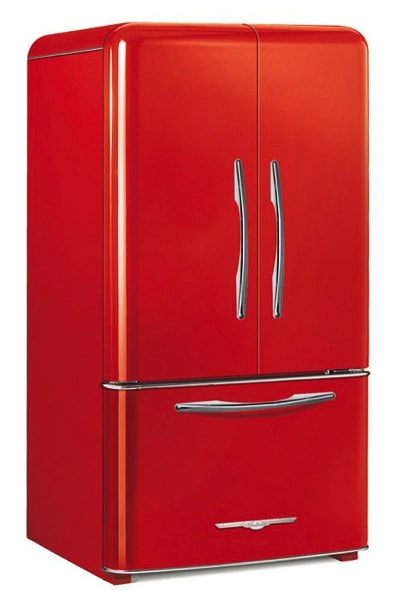
The stainless steel look is the preferred appliance finish by three out of every four people and so wherever possible stay with the popular choice finish.
It is easy to keep clean, is dust resistant and will enhance the value of your home.
If you’re one of the people that aren’t particularly fond of stainless steel, you could always buy less expensive neutral colored appliances that are sold in ‘non-trendy’ colors like white, grey, or similar.
At least these won’t look outdated when the popular trends or desirable styles change.
Many mid-price range and high-end (but still within financial reach) appliances for sale today will get you the right look and quality of performance without having to spend the same vast sums that might be charged on the high-high end models.
Gas or Electricity? Gas is usually quicker, more efficient but the appliances do tend to cost more.
Do make sure you check out the operating cost comparisons between gas and electricity as there may also be a financial benefit to using one over the other.
At the end of the day though, this will probably come down to personal choice or preference.
Refrigerators and Freezers
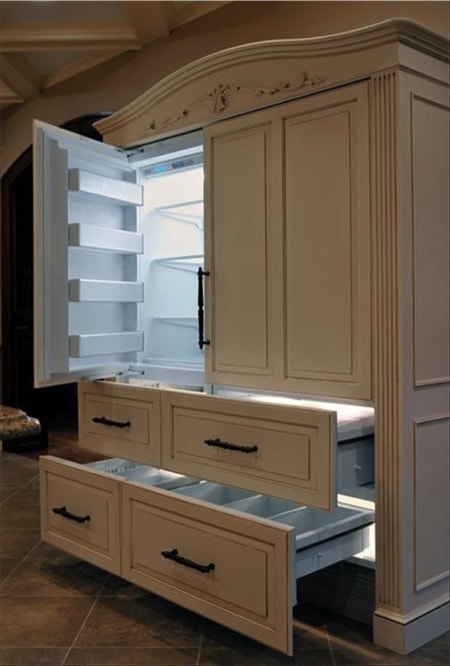
When choosing your fridge, you need to ensure that the fridge you want will fit your allotted space.
This also means you needed to factor in about an inch clearance between the fridge and the cabinet during planning so that it will slide into place easily and also provides adequate airflow around it.
Also, take into account the various dimensions of the fridge and space with the fridge door (or doors) open.
When buying your refrigerator, if it includes a freezer component, consider choosing one where you have eye level refrigeration shelving.
This often means the freezer section is in the lower portion of the fridge. Other aspects to consider when buying a fridge is the capacity of storage.
Don’t get too small a fridge if you have a growing family, you’ll regret it, likewise don’t go massive fridge capacity storage if its only the two of you.
Also, you need to look at a fridge/freezer’s potential performance.
An often overlooked feature is the compressor. A single compressor that is expected to power both a refrigerator as well as a freezer will end up working a lot harder to maintain a moist cool fridge and a cold dry freezer.
Whereas a dual compressor fridge will undoubtedly cost more but it will enable you to maintain your food fresher for longer.
Decide whether or not a water and ice dispenser is a justifiable feature.
For many people, they couldn’t live without the convenience of having instant access to clean filtered drinking water.
This also adds additional expenses in that it often requires the services of a plumber to fit it to the main water supply.
There is also the ongoing maintenance of having to replace the water filters every 6 months or so.
Be wary of certain fridge brands, as they may have proprietary filters that are expensive and only available through their own stores or outlets.
Chest & Upright Freezer
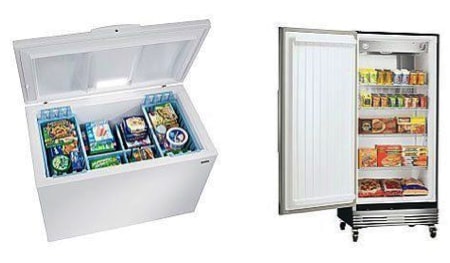
A chest freezer is not an appliance you would normally store inside your main kitchen area.
For many people, they find a normal freezer compartment of a standard fridge freezer doesn’t provide them with adequate freezer storage space.
Consequently, they go in search of a separate chest type freezer for storing additional food items that they then store in their garage, laundry, or basement.
Now there are also side by side and upright door freezers that are available and these are usually matched next to your fridge in your kitchen.
The upright freezer usually takes up a lot less floor space than a chest freezer, they make finding things a lot easier as there are usually defined compartments, however, they’re usually less space efficient and also aren’t as power efficient as a chest freezer.
A chest freezer is the ‘lift up the lid’ type.
They tend to be more energy efficient whilst offering a bulk load of space for storing all types of foods, although they do take up some additional floor space and at the same time (unless well organized inside) can be difficult to locate what you’re looking for, making recycling of food (age wise) a lot more challenging.
The choices of the freezer are wide as there are plenty of different sizes and shapes.
The end choice you make, whether to go with a separate freezer altogether, or whether to have one incorporated within your fridge is really a decision you will have to make based on your personal likes and dislikes, your floor space availability and of course budgetary constraints
Dishwashers
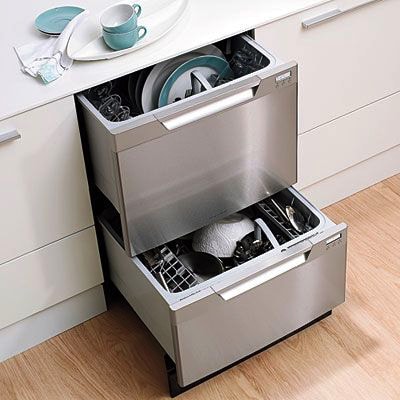
Dishwashers come in many brands, internal layout styles and with a number of feature sets.
There are drawer types that have one or two pull out drawers, making it easier to load.
One of the convenient aspects of this is the ability to install them at heights that suit for ease of loading and unloading.
They can also often have each drawer run independently, making them more economical overall when handling smaller loads.
The traditional dishwasher with pull open door is still the most common and popular style.
There is the ability with some brands to have a kitchen cabinet matching colored panel fitted to the door making the dishwasher blend into the overall kitchen theme better and making it seem less obvious.
Whatever your decision on dishwashers, go with one that will suit your family and your needs, and pay particular attention to the noise output when going through a cycle.
Check the manufacturer’s noise db rating.
This can be an important consideration particularly if your kitchen is in an open plan area that combines dining and living spaces.
Also when choosing your dishwasher, ensure your cooking and cleaning processes suit your choice of a dishwasher.
If you use large cooking pots and pans, then you should look for a dishwasher with adjustable shelving racks.
Cook Tops and Hobs
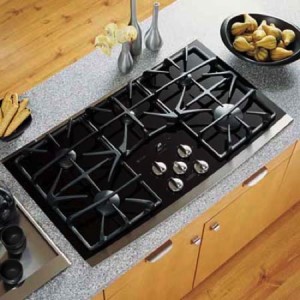
You have a number of choices here.
Firstly, you’ll need to decide whether you choose gas, electric or induction (electric). It’s not that one is better than other, they each have their unique advantages and pitfalls, but ultimately, it just comes down to personal preference.
One thing to note though for popularity is that many people go from electricity to gas, but very few make the decision to go the other way which may suggest some preference for gas amongst most people.
There are also size and style considerations.
There is a lot of choices, whereby you can select from multiple gas burner elements, from small to big, or multiple electric elements.
The overall design of whether you want a sleek look or a traditional look again comes down to personal preference.
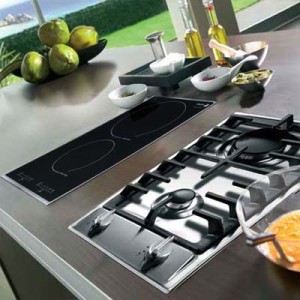
Look for efficiencies and with gas, understand the BTU (British Thermal Unit) measures for each cook hob you consider and what heat loss there could be between burner to pot.
Look for burner grates that are made of cast iron or metal, as these will conduct heat a lot better when transferring heat from the burner to the pot.
Induction units are great, but often are a lot more expensive.
They lose the least heat and are cold to the touch unlike normal electric elements, and when a cooking pot or pan comes into contact, they heat instantly and drop heat just as quickly when the pot is removed, making them considerably safer, unlike electric elements that need to cool down normally.
Ovens
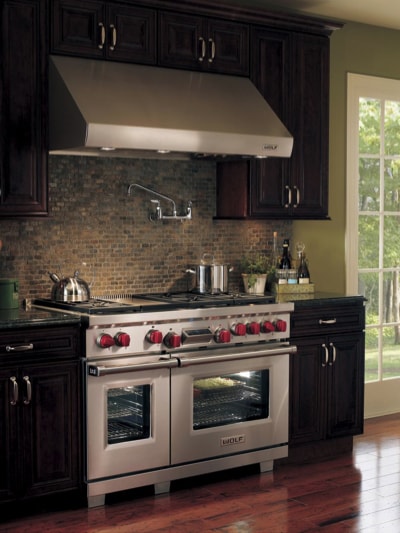
These days ovens have improved their style and look compared to years ago. There is also a lot more choice today than there used to be.
The first thing you need to assess when you are in the market for a new oven is knowing your own requirements.
This takes some reflection on how, why and what you cook. For example, do you bake a lot, or hardly at all?
Do you cook for larger groups of people often, or rarely at all?
Understanding your cooking habits will help you determine what’s important. And will help you narrow down your options.
With a variety of choice often comes confusion.
If you really aren’t too sure what type of oven you should be buying for your needs, then visit a few kitchen/oven retail shops and get some advice from the people that work there.
Explain to them how you cook, how often, and what type of cooking you like to do and let them narrow down your options for you.
Ensure you ask them what the different benefits to you are so that you can decide whether they are worthwhile to you.
There are options that include dual ovens, so in the event, you cook a lot, you can have two items on the go at the same time.
There are also dual -fuel ovens that offer the option of cooking with gas or the controlled temperatures of an electric oven.
Or perhaps you’re happy with the single electric type oven that you’ve been used to.
Your budget will be a big determiner for what you will end up buying.
Stay within the pricing range that you previously determined. But in saying that, also stay with an oven that will meet your needs.
There’s no point scrimping on an oven’s features if they are important to you.
To get the best bang for your buck, check out larger stores that retail these appliances. Often they will have ‘old model’ sell outs, ‘end of line’ sales, or ‘canceled order’ sales.
Understanding when the best time is to buy these appliances, and being prepared to haggle will often see you paying considerably less than the original retail price.
If the same oven is available at multiple retailers, be prepared to make the retailers compete with one and other.
What Oven size or capacity do you need?
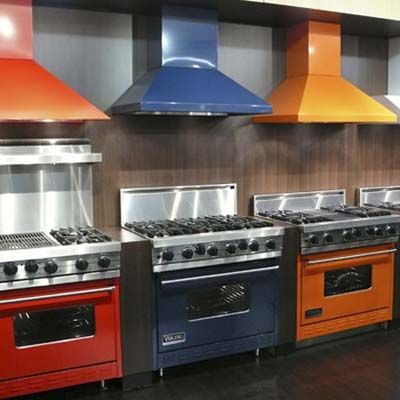
If your cooking involves only casual cooking, ie preparing a few simpler type meals several times a week, then you should be fine with just the standard sized oven.
If on the other hand, you love to bake regularly, or if you often have guests over for dinner parties, then you might want to contemplate a larger oven or perhaps even a dual oven, or twin ovens.
As a guide to overall oven capacity, you should consider the following;
2 to 3 cubic foot oven will fit the needs for one to two people,
3 to 4 cubic foot oven will fit the needs for around three to four people and
Larger than 4 cubic feet will be needed for four or more people
What oven features should I look for?
- Multiple, adjustable tray racks
Usually two racks and sometimes three that can be set to different heights or even removed when not required to make a larger usable oven capacity (like for Thanksgiving or Christmas) - Door locks are common
Door locks prevent ovens doors from being opened during a self-cleaning process, preventing burns, due to these self-cleaning ovens reaching extremely hot temperatures. - Auto start and timer settings
Most ovens these days have a timer and also the ability to set up a cooking time and duration. Great for when you’re at work or away from home and you want to set the oven to start cooking an hour or two before you get home - Finish.
Ovens often come in a range of colors. Go with something that will enhance the value of your kitchen and won’t date, rather than a trendy fad oven that will. A stainless steel finish is timeless. - Window
Ovens usually come as standard with a door window, so you can check on the cooking. This is great when you’re baking and you don’t want to lose heat during the cooking process. Be wary with some brands as there have been some reports of glass doors shattering. - Light
An oven light is a standard feature. Make sure you have the ability to switch the light on or off. Another great feature to enable you to check on your cooking progress visually. - Hidden Element
Some ovens offer the feature whereby the heating element is hidden beneath the base of the oven providing a seamless, easy to clean surface - A Warming Drawer
This is a separate compartment (usually at the base of the oven) where you can place food to keep it warm once it has been cooked, enabling you to conveniently serve a meal all at once. - Convection Fan Forced Cooking
Most ovens should offer this feature. It provides you the option of speeding up the cooking process by turning on a fan to circulate the heat temperatures evenly through the oven during cooking which results in much faster cooking times
Range Hoods
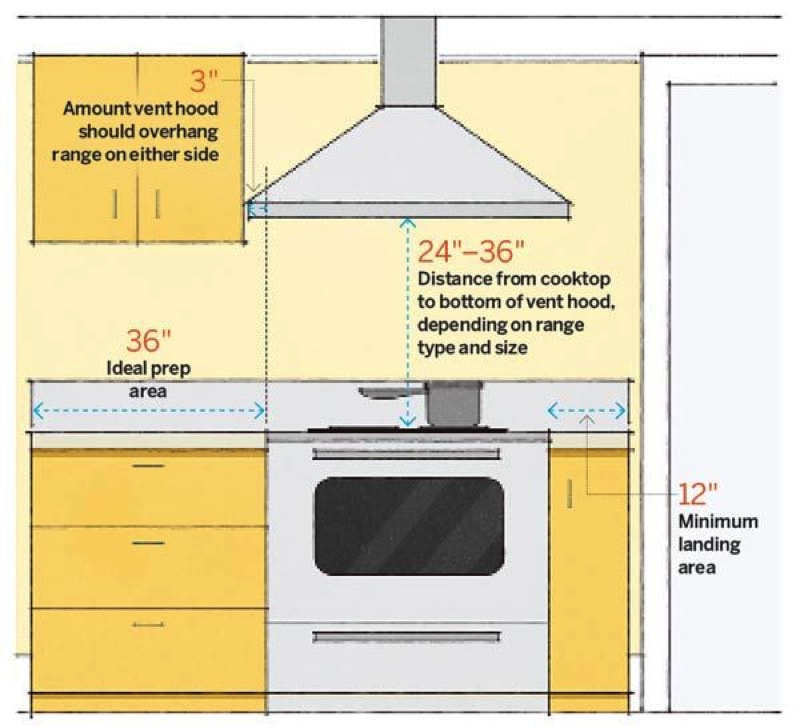
Previously, we’ve suggested or recommended that you invest in a good and efficient ventilation system for your kitchen.
This is where you will get the best return on your investment. If you intend to invest good money in your Oven, then you should also look to invest in a good range hood.
A quality range hood will suck all the steam and cooking smells out of the kitchen and pipe it usually to an exterior outlet.
Good quality systems will always duct the extracted vapors and steam to the outside of the building. Many cheaper extracts will simple recirculate the air within the kitchen and are totally ineffective.
Don’t under any circumstances purchase a range hood that doesn’t extract the vapors, fat droplets and steam outside of the kitchen, unless there is no other alternative, in which case you could look to purchase an extract system with a recirculating kit.
These allow extracted air to be filtered through a carbon filter that will trap and capture the unwanted cooking air contaminants. After the air passes through this carbon filter, it can be reintroduced back into the kitchen, grease, and odor free. (But not heat free)
These systems can require regular maintenance by way of regular cleaning or exchanging of the filters.
It’s so easy to get caught up shopping for a great looking hood without giving much thought to the technical considerations of how well the range hood is going to work in your kitchen.
Part of your planning process should have considered the various options open to you.
If you have a kitchen island, do you intend installing the cook top in the island bench?
If so, will you make your extractor hood a featurepiece?
Do you prefer an inconspicuous downdraught system or do you like the look of the traditionally styled range hood?
The first point you need to understand is the way technical people refer to the power of the range hood fans. You may see listed in various brochures and product catalogs an acronym called CFM.
That actually stands for ‘cubic feet per minute’ and the bigger the CFM number, the more air the range hood is capable of removing within a single minute.
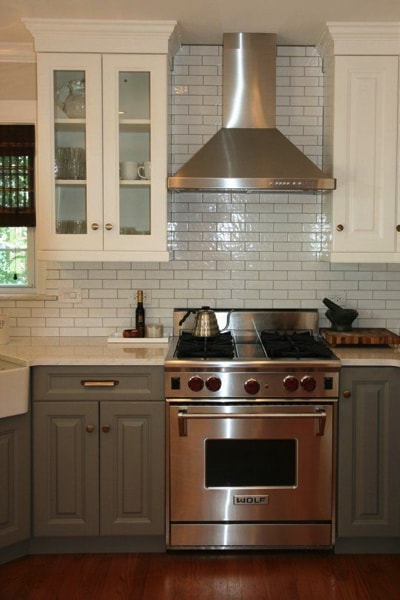
Your own kitchen needs will depend on both the size and the type of your cooker or cook top. Your type of cooker, as well as the frequency with which you cook, will also play an important aspect in your decision making.
For instance, a six-burner gas hob will require more CFMs than what a 30-inch-wide electric cooker will.
The usual requirement for an electric cooker is between 300 to 450 CFMs.
A gas cooker will require between 600 to 1,200 depending on the amount of BTUs (British thermal units) it produces.
If this confuses you, don’t panic, the retail outlet, or store where you buy your cook top, or range hood, will be able to guide you in the right direction for CFM capacity required by your cooker choice.
Depending on your local Council, there may be certain building codes in your municipality that insist on the installation of what is known as a ‘make-up air’ device.
This is of particular importance more so for remodeling and renovations. This is a system that effectively replaces the extracted ‘bad’ air that leaves your kitchen with clean air to balance the pressures inside and outside.
Check with your Council first.
Another factor that will probably become apparent to you is that these systems can be somewhat noisy, however, the fact that you have different extract fan settings is a good thing, as you’ll be able to control the extent of the noise by controlling the fan speed.
If however, you find it too loud, and you really don’t want the noise in the kitchen, it is possible (but will be more expensive) to have a unit installed whereby the extract motor is housed outside.
For the most part, however, your need for the extract fan will be on the gentlest of fan speeds.
You only want the fan to extract at the maximum speed when you’re cooking specific ‘smelly’ foods (like tripe, or curry) that you don’t want lingering smells left behind. Most other times, a low operating speed will suffice.
Kitchen Sinks
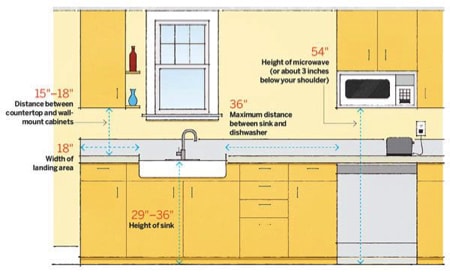
For many people building a new kitchen or undertaking a remodel of an old one, the kitchen sink is often the last thing to be considered, and even then, there usually isn’t a lot of thought put into choosing the one that will match your needs and requirements.
Now its often ideal to choose your sink at the same time as you choose your kitchen cabinets, as that will also help to determine the way the sink is likely to be installed, however in saying that, there are still many things to contemplate and make decisions about.
Because sinks come in many different sizes, shapes, functions, and materials, there is a lot of choices.
Much of that choice will be determined again, by you and how you live, cook, and wash up.
How tall are you and therefore how deep do you want the sink to be (or not to be)?
Do you want a separate area to your kitchen, like a Butler’s pantry where you can have an extra large washup sink?
What material do you want it made from?
You have a vast array of choices from pressed stainless steel, enameled cast iron, porcelain, fiberglass, acrylic, stone, marble, composite or quartz, and probably many others.
The one you choose will be determined by your budget, and whether or not you like to prep the dished before putting them in a dishwasher.
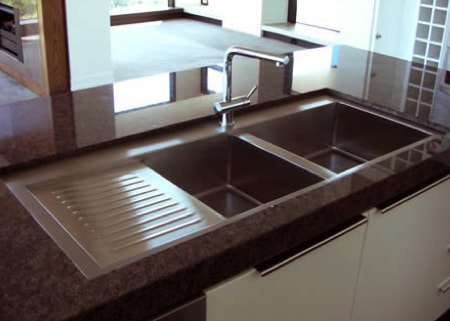
Do you prefer the twin sink variety, or the triple sink type, or just a single kitchen sink type?
Do you want the sink to include an extended draining area for dishes?
Lots of things to contemplate, however, you’re best to head down to a local kitchen manufacturer, or plumbing merchant that will have a variety of sinks and sink types an display.
If you’ve invested in a quality expensive countertop, don’t go cheap on the sink.
When it comes to installing the kitchen sink, there is the under countertop (under-mounted) installation and the above the countertop installation.
Each scenario has their own applications and a lot of it comes down to preference and budget.
If you install a sink underneath your countertop (in other words, the sink gets installed first, and the countertop is fitted on top) and if for whatever reason, it needs to be replaced, you’re potentially up for an expensive exercise. (Although this would be rare)
Garbage Disposal units / Waste Master Insinkerator
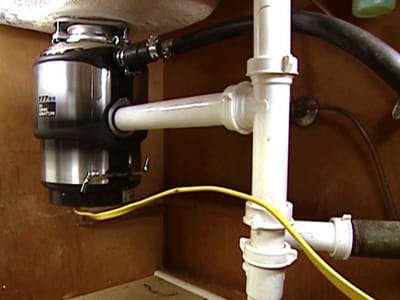
Depending on where you’re from, you may know this hidden discrete device as a garbage disposer, or a waste master or perhaps even an InSinkErator.
Whatever you know it as, they are one of the most practical devices available for disposing of unwanted, end of dinner scraps, peelings, and other small organic waste quantities.
When making a decision on which one is most suitable for your kitchen needs, you’ll need to make a decision between the batch feed type or the continuous feed type.
The essential differences between the two are that the continuous feed type runs as long as the switch is flipped, whereas the batch type will only turn on when the disposal cover is in place.
The continuous type is the most common. The batch feed models offer an extra level of safety and injury prevention.
When it comes to budgets and how much to spend, it’s the horsepower rating you need to take into account, as it will be this that affects the overall pricing of the units. The more horsepower, the more powerful and the more expensive.
However, in saying that, it doesn’t necessarily mean that everyone should go for the biggest horsepower, it all comes down to how big your family is and how much demand the unit will get.
The smallest garbage disposal unit is likely to be around ¼ horsepower, with the biggest being around 1 horsepower.
If you don’t need to grind hard items like chicken bones, egg shells, citrus skins, and the like then the lower power options will suffice. It’s a matter of getting the balance right.
Choosing a unit that is too small for your needs and you’ll end up having to constantly reset the unit as many will also have a cut off switch if the load is too much.
If keeping the noise down to a minimum is important when operating one of these units, then you may need to look at the more expensive units as a lot of these will have noise dampening material built into them.
The cheaper units invariably won’t and whilst they do a great job, they will still be somewhat noisy. (Albeit for a few seconds whilst in operation)
Built-in Coffee Makers
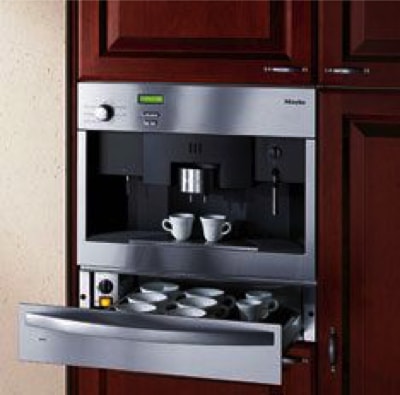
How times have changed over the years.
Coffee has always been a long-held social tradition amongst many western civilizations, and in recent years, home kitchen appliance manufacturers have jumped on the café trend by offering their clients the option of another appliance.
The built-in coffee maker. One that you can have installed into your kitchen cabinetry eliminating the workbench clutter of numerous infrequently used appliances.
For those who adore their coffee, and want to have access to a café style real coffee can now include one of these machines in their kitchen renovation or new kitchen build
Usually measuring (frontal display) around the same dimensions as a microwave, or small oven, these units are able to be easily installed or allowed for by the kitchen cabinet maker without being too obtrusive.
Probably something you would avoid if space is at a premium, however, that all depends on how much you love your coffee.
You can expect to pay upwards of $2,000 for one of these
Appliance Finishes
The only other thing to consider about your various home kitchen appliances is the finish you would prefer in your kitchen. Stainless steel is probably the most practical choice for the ‘dateless’ look, and most appliances will be available in a stainless steel finish.
Be careful about selecting colored appliances as these will definitely become dated over time.
Also, be careful when selecting the stainless steel look as there are various qualities available. It’s the old story, you get what you pay for, so just be extra vigilant when hunting out those bargain appliances.
Stainless steel is rated depending on its gauge (thickness). The higher the gauge number, the more the appliance will look shiny and sleek and it also means its likely to be a better quality, longer lasting product.
Check Out the Kitchen Design & Planning Guide by Clicking on the Link Below
Kitchen Design Ideas and Planning Guide